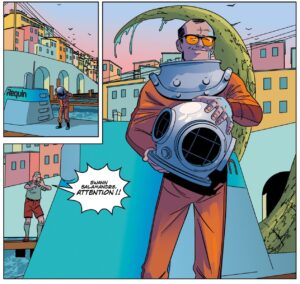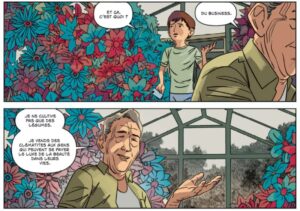I.N.J. Culbard, a cartoonist celebrated in Everything, is in Salamander alone at the command of a ship describing a strange and haunting country, Obelisk. But, by reading our column, you will discover that this country is more real than one might think…
A lost child

Salamander follows young Kasper Salamander into a family with many tensions. This fragile balance collapses following the sudden disappearance of the father of the family. Salamander then describes the different reactions or stages of grief. Kasper hopes for his father's return. Without recourse, his mother appeals to the grandfather but it is an original. Indeed, Salamandre presents us with a family of creators. If the son Kasper draws adventures like Culbard, the mother paints. However, Kasper has not drawn since his father's death. He has lost his smile and the book will follow his transformation.
Salamander is the touching portrait of a child. Kasper discovers a new country while experiencing new pain and gravity. He will seek to take advantage of the country's opportunities to forget but his clumsy attitude then endangers his family.
An imaginary biography
While going to his grandfather's house, Kasper discovers another world. Salamander is a geographical comic. The father is a deep-sea explorer in a country where the topography is absurd: Mount Charlemagne, the trench of gifts… An iron veil hermetically separates the main island in two. Salamander plunges us into an imaginary world with many mysteries. While taking the train Kasper meets a chubby man dressed all in black who can make customs officers bend. As in a treasure hunt, he goes in search of paintings stolen during the Second Great War.
Paradoxically, Salamander is a very symbolic autobiography. Indeed, Salamander is inspired by Culbard's personal history, his travels between England and Poland. All the absurd details that dot the narrative may actually be his childhood memories. The portraits of the dictator in the living room show the cult of personality of General Jaruzelski. Yet revolutionary artists continue to create in secret.
If the police spy everywhere, corruption and resourcefulness offer a space of freedom in a country where everything is forbidden. Culbard pushes the absurdity of this life to the maximum.
Exceptional drawings and editing 
Behind a very wise, very Franco-Belgian layout, I.N.J. Culbard multiplies inventions. The child thinks his Obelisk family is going crazy dancing in silence but the notes appear on the box when he understands the reasons for this silent celebration. In one box, we go from the real to the imaginary. Despite the theme of mourning, we avoid the banal noir. On the contrary, there are very beautiful contrasts and great diversity depending on the pages. In the night, the yellow eyes of cats symbolize the omnipresence of the political police.
Once again, we can only salute the work of the publisher 404 comics. The setting for Salamander is superb. The grainy cover mimics the shape and texture of photo albums. The author and the title are hollow. This floral profusion continues inside the book, before a map presents this imaginary world. The reader is immersed in the narrative in seconds. After the last page, he remains hooked by the sketches on the characters and covers.
Salamander is a key narrative that is as easy to read on the surface as it is of formidable density in depth. On the one hand, we are immersed in a strange and often absurd world. Gradually, the reader thinks he finds the keys to the story. It was Kasper who could not interpret reality because of his loneliness. Culbard unnerves us one last time, tipping Salamander into the tale. On the other hand, the author draws a portrait of the Poland of his childhood.
Find the chronicles on two volumes of Invisible Kingdom from the same Berger Books collection.



















